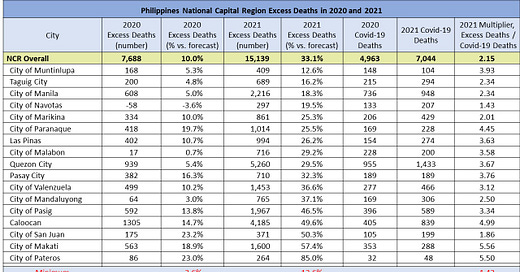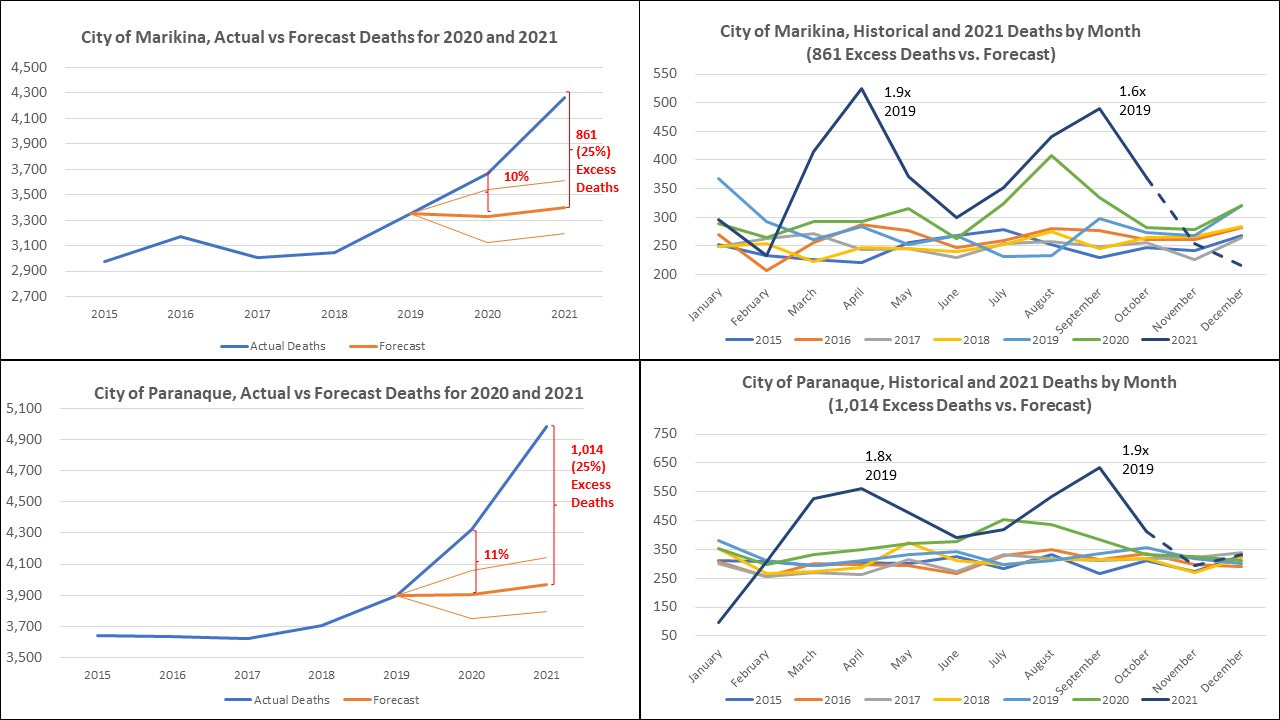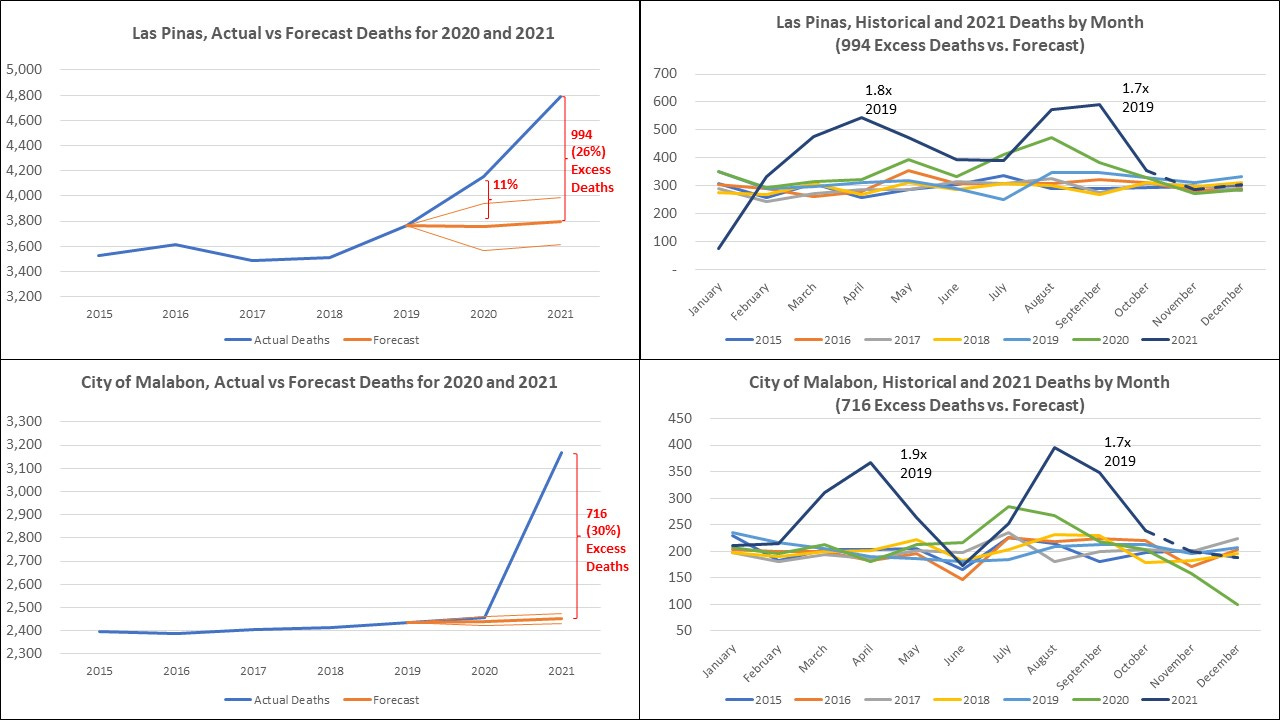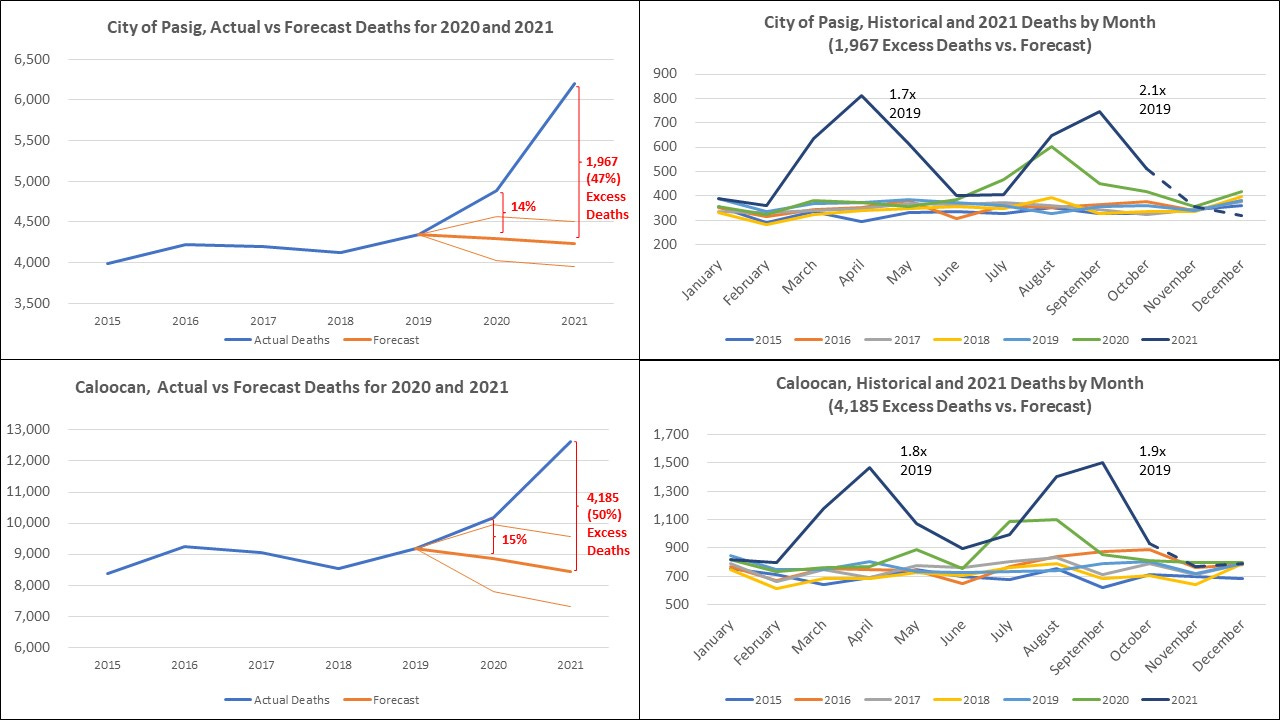All Cause Mortality in National Capital Region in 2020 and 2021 Cities, Compared Against Forecast Mortality Using 2015-2019 Data, and Covid-19 Deaths.
All cause mortality in all NCR cities show 2 distinct peaks in 2021, exactly concurrent with the Covid-19 Vaccine Rollouts. Many NCR Cities had excess deaths in 2020, and even higher deaths in 2021!
Do not forget that this analyses, though dealing with cold and exacting figures, refers to real people, real lives no longer lived, real families with loved ones passed! Please bear this in mind and offer a prayer or thought, for these people, while reading this report!
National Capital Region (NCR) is a central Luzon Administrative Region, which includes Metro Manila. It is a highly urbanized area which was home to 13.48 million inhabitants in 2020, and 12.4% of the entire population of the Philippines.
As part of a further analyses on the patterns of mortality in the Philippines in 2020 and 2021, analyses of deaths in NCR, as a whole, and in the 17 cities of NCR was carried out, and compared against forecast deaths using 2015 to 2019 data input into excel forecast. Excess deaths were also compared against DOH reported Covid-19 deaths to determine if Covid-19 could have explained the excess death; assuming, falsely but conservatively, that all Covid-19 deaths are excess deaths.
All source data is publicly available online from the Department of Health, and the Philippines Statistics Authority.
This table summarizes the data for NCR and her cities. 2020 had 10% excess deaths vs. the forecast deaths (Range -3 to 23.2%), while 2021 had 33.1% excess deaths vs. forecast (range 12.6 - 85%). Nearly all cities had excess deaths outside the confidence bounds of the excel forecast. On average, Covid-19 could only possibly explain less than half of these deaths, with a range from 18% in Makati up to 70% in Navotos.
Spikes in 2021 monthly deaths were compared against 2019 levels, the last “normal” year prior to the pandemic to give some idea of the magnitude of the death spikes in the 2nd and 3rd quarters of 2021.
NCR overall data is presented graphically showing actual deaths against forecast deaths, covid-19 reported deaths across the pandemic, and the pattern of deaths in 2021 compared to historical death patterns.
Deaths in January and February of 2021 were unexceptional. Deaths rose sharply in March 2021 to 60% above 2019 levels before dropping off somewhat by June. Excess deaths rose again in July and were 1.9x and 1.7x 2019 levels by August and September.
There were 7,688 excess deaths in 2020 and 16,139 excess deaths in 2021 compared to the forecast death levels derived from historical 2015 to 2019 vital statistics. The excess deaths in 2020 are of particular interest because many areas outside of Metro Manila, did not have excess deaths in 2020. Further the overall deaths in 2020 in the Philippines were lower than the overall deaths in 2019.
There were 7,044 Covid-19 attributed deaths in 2021, 41% higher than the 4,963 deaths attributed to Covid-19 in 2020. Over-attribution of covid-19 deaths is likely to have occurred but is not topic for this discussion. The Covid-19 deaths cannot explain all of the excess deaths in either 2020 or 2021, and other causes will need to be identified. It is possible that the heavy lockdowns applied across the Metro did exact a death toll through poverty, hunger, isolation, lack of access to medical care, and contributed to these deaths more so than would have occurred in rural areas. There is also the possibility that the prescribed medical management of covid-19 in hospitals contributed to additional deaths. Provincial folks have less access to medical care than residents in the metropolis. Less chance of nosocomial (medically induced) adverse events.
In 2021 every single city shows two waves of excess deaths. These match the two spikes of deaths attributed to the delta wave of the Covid-19 pandemic and they also match the rollout of the covid-19 vaccines. The first spike was immediately concurrent with the rollout to healthcare workers, the elderly and the vulnerable. The second spike happening in August 2021 was also immediately concurrent with the rollout of covid-19 vaccinations to the general population. As has been previously noted, the end of year data for 2021 is still incomplete. Final excess deaths will be higher than those reported here.
The data for each city is self explanatory. We are witness to an unprecedented loss of life in 2020 and 2021 for these cities.
Pateros, a small city with 65,227 residents in the 2020 census, had the worst outcomes of all cities, though the forecast range is greater given the small population. They saw 23% excess deaths above forecast in 2020 and 85% excess deaths above forecast in 2021.
The normal death patterns in early 2021, followed by spikes greater than can be explained by covid-19 strongly implicate the vaccination rollout as one causative factor.
Detailed examination of this data by government and health officials should be considered.














Keep at it, Sally!
Hi Sally, these are very compelling numbers. I presume that since these are belated tabulations, these are not included in the petition(s) filed with the Supreme Court, right? However, "concerned citizens," especially those who have lost loved ones (in my close family circle, we've suffered 7 casualties already), should ram these data down the throats of their congressmen and senators, especially those who hold membership in the Health and other relevant committees, including joint oversight, in both houses of the 19th Congress. Demands must be made by constituents for a congressional investigation by either house of Congress (or both) of former officials and personalities complicit in the Covid-19 pandemic response and management that led to THIS TRAGIC OUTCOME as borne out by your analysis of the numbers. This will generate much awareness and galvanize opposition to the vaccination program like the blowback associated with the Dengvaxia scam. Sen. Bong Go still holds chairmanships of Health and Demography and presumably also the Joint Congressional Oversight Committees on Universal Health Care and National Health Insurance Program. He should be moved to act on this even if the former officials are his friends under the previous administration. The Lower House has not named a new Health Committee chair yet. Should Usec. Vergeire be endorsed as Sec. of Health, her appointment should be blocked in the separate powerful Commission on Appointments. THE NUMBERS SAY IT ALL!